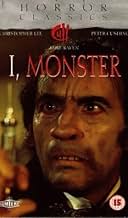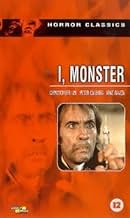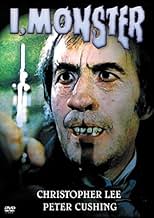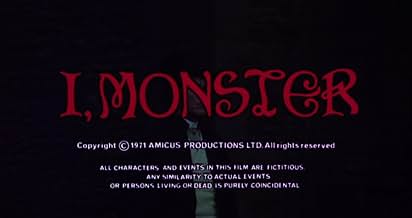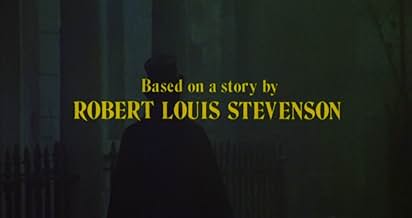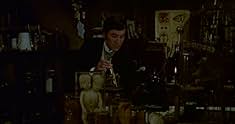Füge eine Handlung in deiner Sprache hinzu19th-century London psychologist Charles Marlowe experiments with a mind-altering drug. He develops a malevolent alter ego, Edward Blake, who his friend Utterson suspects of blackmailing Mar... Alles lesen19th-century London psychologist Charles Marlowe experiments with a mind-altering drug. He develops a malevolent alter ego, Edward Blake, who his friend Utterson suspects of blackmailing Marlowe.19th-century London psychologist Charles Marlowe experiments with a mind-altering drug. He develops a malevolent alter ego, Edward Blake, who his friend Utterson suspects of blackmailing Marlowe.
- Regie
- Drehbuch
- Hauptbesetzung
- Landlady
- (as Aimee Delamain)
- Pub Patron
- (Nicht genannt)
- Girl in Alley
- (Nicht genannt)
- Woman in Alley
- (Nicht genannt)
- Man At Bar
- (Nicht genannt)
- Man in Pub
- (Nicht genannt)
- Pipe Smoker (with Cap) in Pub
- (Nicht genannt)
Empfohlene Bewertungen
The story has a doctor called Marlowe developing a drug that releases his patient's inhibitions, for example, turning a sexually repressed woman into a nymphomaniac. To further test it he starts taking it himself. It turns him into Mr. Blake an evil man who grows increasingly more physically repulsive the more times he takes a dose. Marlowe is ordinarily a very inhibited and cold man, whereas Blake is libidinous and carefree. Needless to say he is also murderous too and soon there is a manhunt on to discover who is responsible for these crimes.
Amicus made a fairly commendably earnest adaption here it has to be said. The production benefits from some authentic Victorian England locations and like other costume horrors from Britain from the period, its low budget is hidden quite well by the sets and costuming. It also has the two British stalwarts of the genre at its disposal in Christopher Lee and Peter Cushing. Lee has a fair bit to sink his teeth into in this dual role as Marlowe/Blake and he puts in a very good performance. Cushing is solid as he ever is but his role is very run-of-the-mill for him really and he doesn't get to do much beyond what we've seen him do umpteen times. Despite being quite faithful to the original source there are some amendments that have been added to make it slightly more modern such as Freudian theory underpinning things or the fact that Marlowe uses an intravenous drug as opposed to drinking a potion. On the whole though, like lots of these Amicus/Hammer period horrors, this one is solid more than great. There consequently isn't anything too surprising but if you are a fan of the sub-genre then this is certainly a good enough example.
"I, Monster" is another version of the classic story of Dr. Jekyll & Mr. Hyde. The art direction is very beautiful and the great attractions are certainly Christopher Lee and Peter Cushing. My vote is six.
Title (Brazil): "O Soro Maldito" ("The Damned Serum")
Having said that, 'I, Monster' is the most faithful of all adaptations of Stevenson's great novella. There is a little chronological tinkering with narrative, and the setting is moved forward by two decades; but the plot and characters are largely Stevenson's. The error made by most versions of making Jekyll good and Hyde bad is avoided - Jekyll/Marlowe is from the start morose, anti-social, sadistic, voyeuristic and scientifically dubious. There is no Hollywood love-interest, pucelle/putain story to simplify Marlowe's dilemma, retaining the claustrophobic, homosocial world evoked by Stevenson.
Instead of the usual Victorian, cod-Gothic fug, the novella's dream-like modernity is stretched, with effective use made of silence and an unnaturally depopulated urban labyrinth. The transformation scenes, usually an excuse for distracting effects-extravaganza, are brilliantly subtle here, usually off-screen. The 'revelatory' scene (when Blake reveals himself to a friend) is done in silhouette, which is more evocative and thematically appropriate. Christopher Lee's patrician adventurousness is effectively contrasted with Peter Cushing's dogged dullness.
Of course, when I say 'I, Monster' is more faithful than most, it's still not very faithful at all. The duality in Stevenson, whereby Jekyll and Hyde being the same person is concealed till the end, is ignored here. More pertinently, setting the novel in 1906 makes the story seem perversely anachronistic, where Victorian ideas and motifs (sexual repression, duality, mad science etc.) seem out of place in Edwardian England. There is a reason for this - Marlowe is a devotee of Freud, and Jekyll's attempt to isolate, and hence exterminate, the essence of evil, is given a psychoanalytical spin, where the duality is not between respectability and desire, but the ego/super-ego and the Id.
This is interesting for two reasons. Firstly, Freud's ideas of the mind are transferred to the body, giving resonance to Marlowe's physical changes, the animal imagery throughout, and the violence he inflicts, as well as making more poignant the climactic 'melding', where Marlowe can no longer divorce his dark side at will. Secondly, Freud provides an explanatory framework for the story, most notably an Oedipal one. Blake runs riot with a cane that reminds Marlowe of the one his violent, 'respectable' father used; the absence of women in his social world, his horrifying violence to women, and some of the seemingly irrelevant asides (the photos that loom in his room like an invading army, etc.) all suggestively deepen our reaction to Marlowe's plight.
This Amicus production is reminiscent of the best Hammers - eg 'The Creeping Flesh' - where the emphasis is less on gore and sensation than suggestion, atmosphere, or slow menacing camerawork; a meaningful use of decor; dream-like sequences; elliptical editing; rich symbolism.
And as with those great Hammers, there are some searing set-pieces - the opening credits in Marlowe's laboratory, with its dead Siamese twin foetuses, its caged animals and images of fragmentary body parts; Marlowe's first injection and 'self-discovery' with the mirror (more Freud via Lacan) and 'new' point of view; the knife tussle at dawn in a narrow lane in a proletarian milieu; the voyeuristic scenes in his adopted hotel room, with its low-level, tilted camera; the social humiliation when he tries to pick up a prostitute, suggesting he hasn't quite overthrown the sensitive super-ego; the trampling of a young girl. Lee, usually so authoritarian and calm, gets a rare chance to be weak and is excellent; his hurt at having to kill his tabby is very moving. Also excellent is the score, ironic and commentating rather than underpinning or atmospheric; frequently comic, but never - ever - spoofy.
Wusstest du schon
- WissenswertesChristopher Lee (Dr. Charles Marlowe / Mr. Edward Blake) previously played Paul Allen in Schlag 12 in London (1960), another film adaptation of Robert Louis Stevenson's 1886 novella "Strange Case of Dr. Jekyll and Mr. Hyde."
- PatzerAt c. 53:00 into the film, Utterson says he would recognize the exact details of the ornate head of Blake's cane. However, he has only seen this cane for a fraction of a second at nighttime, when it was used to assault him earlier in the film.
- Zitate
Dr. Charles Marlowe: The face of evil is ugly to look upon. And as the pleasures increase, the face becomes uglier.
- Alternative VersionenOn Blu-ray, the film was released for the first time by Powerhouse Films in the UK. In addition to the theatrical version, there is the option to watch the extended version, which features two additional scenes. You can see Marlowe working in the lab, more conversations in the club and a conversation of Marlowe with his patient Diane. The scenes mainly deepen the theme of human duality, but are not strictly necessary.
- VerbindungenFeatured in The Many Faces of Christopher Lee (1996)
- SoundtracksEine Kleine Nachtsmusik
By Wolfgang Amadeus Mozart (uncredited)
Top-Auswahl
- How long is I, Monster?Powered by Alexa
Details
- Erscheinungsdatum
- Herkunftsland
- Sprache
- Auch bekannt als
- I, A Monster
- Drehorte
- Produktionsfirmen
- Weitere beteiligte Unternehmen bei IMDbPro anzeigen
- Laufzeit1 Stunde 15 Minuten
- Seitenverhältnis
- 1.85 : 1
Zu dieser Seite beitragen




